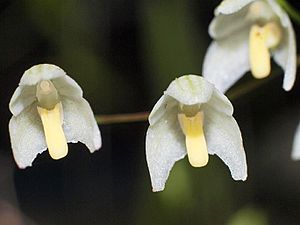Cupped strand orchid facts for kids
Quick facts for kids Cupped strand orchid |
|
|---|---|
 |
|
| Scientific classification | |
| Genus: |
Bulbophyllum
|
| Species: |
newportii
|
| Synonyms | |
|
|
The Cupped Strand Orchid (scientific name: Bulbophyllum newportii) is a special type of orchid. It grows on other plants, like trees (this is called epiphytic). It can also grow on rocks (this is called lithophytic). This orchid is found only in Far North Queensland in Australia.
It has light green, oval-shaped parts called pseudobulbs. These are like small storage units for water and nutrients. Each pseudobulb has one stiff, dark green, egg-shaped leaf. The orchid also produces up to eight bell-shaped flowers. These flowers can be white, cream, or greenish. They have a long, narrow yellow part called a labellum, which is like a landing pad for insects. You can usually find this orchid growing on trees and rocks in higher places.
What it Looks Like
The Cupped Strand Orchid is a herb that forms thick groups. It has a creeping stem called a rhizome that spreads out. Along this stem are the light green pseudobulbs. They are about 8 to 15 millimeters (0.3 to 0.6 inches) long and 8 to 12 millimeters (0.3 to 0.5 inches) wide.
Each pseudobulb has a single, stiff, dark green leaf. This leaf is egg-shaped to oblong. It measures about 40 to 70 millimeters (1.6 to 2.8 inches) long and 8 to 12 millimeters (0.3 to 0.5 inches) wide.
The orchid produces up to eight bell-shaped flowers. These flowers are white, cream, or greenish, and sometimes even pink. They are small, about 4 to 6 millimeters (0.16 to 0.24 inches) long and 4 to 5 millimeters (0.16 to 0.20 inches) wide. The flowers grow on a thin stem that is 50 to 90 millimeters (2 to 3.5 inches) long.
Each flower has different parts:
- The dorsal sepal (top part) is egg-shaped. It is 4 to 7 millimeters (0.16 to 0.28 inches) long and about 3 millimeters (0.12 inches) wide. It forms a hood over the column, which is the central part of the flower.
- The lateral sepals (side parts) are triangular and curved. They are 5 to 7 millimeters (0.2 to 0.28 inches) long and 3 to 4 millimeters (0.12 to 0.16 inches) wide.
- The petals are about 3 millimeters (0.12 inches) long and 1.5 millimeters (0.06 inches) wide.
- The labellum (lip) is yellow, fleshy, and curved. It is about 5 millimeters (0.2 inches) long and 1.5 millimeters (0.06 inches) wide.
This orchid usually blooms between September and December.
How it Got its Name
The Cupped Strand Orchid was first officially described in 1902. A botanist named Frederick Manson Bailey gave it the name Sarcochilus newportii. He published this description in a book called The Queensland Flora. The plant he studied was collected on Mount Alexandra by Howard Newport.
Later, in 1909, another botanist named Robert Allen Rolfe changed its name to Bulbophyllum newportii. The second part of its scientific name, newportii, honors Howard Newport, who found the first plant specimen used for its description.
Where it Lives
The Cupped Strand Orchid grows on trees and rocks. It prefers places that are high up, usually in areas that are humid and have good air circulation. You can often find it in exposed spots. It lives in Queensland, specifically in the McIlwraith Range and between Cedar Bay National Park and Eungella National Park.

